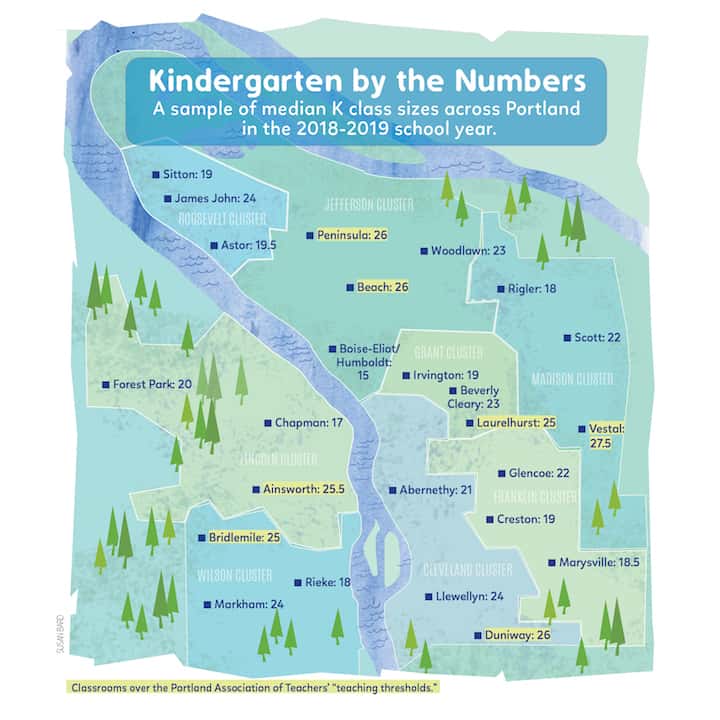
A state education funding windfall could mean smaller class sizes at PPS schools. But are reduced student-teacher ratios really a cure-all? Parents, administrators, educators and legislators weigh in.
As the mother of three boys in third, sixth and 10th grades, Lisa Kensel has a lot of school experiences to compare.
Each of her boys has attended Creston K-8 School in Southeast Portland’s Creston-Kenilworth neighborhood. They’ve even had the same kindergarten and first-grade teachers, she said.
But two words underscore a crucial difference between the experiences of her oldest boys and her youngest: class size.
Owing to population shifts in Southeast Portland, Kensel’s third-grade son has had far smaller classes than his older brothers for kindergarten and the first and second grades. While the older boys had classes of 25 to 28 kids per year, the youngest boy started school with just over 20 kids. There were 19 children in his first-grade class, said Kensel. And in second grade, a last-minute dip in enrollment at Creston resulted in two classes of 14 students each.
And while that’s unusual in the Portland Public Schools district, where the average class size for second graders last year was 24, Kensel was ecstatic. She attributes her son’s success as a strong reader to the individualized attention his second-grade teacher was able to give him.
“I’ve seen the impact that smaller classes have had,” she said. “My youngest is where is he because of a small class size.”
Recent campaigns by the statewide teachers union, the Oregon Education Association, show that principals, counselors, teachers, parents and students almost universally want class sizes that are smaller than the statewide average of 25. (That number is for all subjects and grade levels, according to the Oregon Department of Education.)
Kensel, the Creston mom, knows this firsthand. As president-elect of the statewide Oregon PTA, she hears from parents all the time about what they want to see at their children’s schools. And Kensel knows she’s not alone in wanting to give teachers the opportunity to focus on children’s different needs — even her colleague at the Oregon PTA, current President Kristi Dille, made the decision this year to send her daughter to private school, after the girl pleaded with her parents not to send her to Rex Putnam High School in Milwaukie, owing to the large class sizes.
“Statewide, class sizes are a concern for most every parent,” Kensel said. “We all want our kids to have a robust, individualized education.”

The politics of class size
Perhaps surprisingly, the harmony over class size even extends to our most disharmonious state institution: the Oregon Legislature.
In May, Oregon lawmakers enacted what they called the Student Success Act, a sweeping new tax on businesses’ gross receipts that they expect will raise $1 billion a year for Oregon schools.
One of the driving forces behind the effort to raise business taxes was the desire to give districts the opportunity to reduce class sizes, said Rep. Barbara Smith Warner (D-Northeast Portland), who successfully shepherded the bill to Gov. Kate Brown’s desk.
The Student Success Act, which goes into effect in 2020, doesn’t mandate how districts must use the new revenue because the needs of rural Oregon schools are different from those in cities, said Smith Warner, but she said she expects some districts will want to tackle the problem of ballooning class sizes. “I expect class sizes to go down in a number of places,” she said.
The new tax grew out of a bipartisan barnstorming, what lawmakers called the Joint Committee on Student Success, co-chaired by Smith Warner. The committee, made up of state representatives and senators from the Democratic and Republican parties, toured multiple school districts, talking to community members, teachers and students in 2018. Smith Warner said the need to reduce class sizes came up often in those tours, including in one district that had a calculus class with 45 students and only 40 desks.
Class size, she said, is shorthand for a lack of resources among schools. “It’s definitely big,” she said. “It’s the thing that people instinctively understand.”
After the bill passed, fellow Democrats elected Smith Warner their new House majority leader, owing in part to her legislative funding victory. The bill overcame significant Republican opposition over its taxing methods, including a four-day walkout by Republican legislators during the 2019 session, but not over what it aimed to do. (Republicans said they feared the tax on businesses would trickle down to consumers.)
But visible pressure from teachers, thousands of whom rallied in Portland on May 8 for more statewide resources, helped clinch the deal.
“It’s more crucial than ever that students get the individual attention they need,” said Elizabeth Thiel, vice president of the Portland Association of Teachers union that operates under the OEA umbrella. “This is one of the most important issues to us.”
Further pressure in Portland
Also last year, Portland Public Schools adopted new language in its labor contract with teachers that establishes what it calls “teaching thresholds,” to control class sizes. The thresholds aren’t technically caps on class sizes, but if PPS administrators want to go over agreed-upon limits in a classroom (the threshold is 24 students for kindergarten, 26 students for first through third grade, and 28 students for fourth and fifth grade), the district must hire a classroom aide or pay the teacher an overload fee of 3 percent of the teacher’s annual salary.
In the 2019-20 school year, PPS expects to pay about a third of its classroom teachers overload payments totaling about $2 million, according to the district. In part, that’s because PPS doesn’t use the teaching thresholds at all when it decides how and where to allocate teachers; it uses a staffing formula that allows far bigger classes in all but the poorest schools (up to 29 children in kindergarten, 31 students in first grade, 32 students in second grade, 33 students in third grade, and 35 students in fourth and fifth grade, according to the 2019-20 staffing model.)
Erin McKee, a second-grade teacher at Faubion, a Northeast Portland PK-8 school, said she’d much rather have a smaller class than get bonus pay, as she did last year. “It made me uncomfortable thinking about kids as an extra paycheck,” she said, noting she had 28 students last year, two over the threshold the union helped set. “It was compensating me, but students are the ones who should be receiving extra support and services.”
Faubion underwent a major rebuild recently. When it reopened in 2017, 28 coat hooks lined the wall to McKee’s classroom, but she had 32 students. She had only 30 squares on her carpet. She’s been told to expect 30 kids this fall. “It’s sad, but I’m actually getting used to having that many,” said McKee, who assigns jobs to students to help manage the volume of classroom tasks. “I know it can be done. It’s really heartbreaking though, because I miss the one-on-one time.”
Thiel thinks the 2018 contract language is a step in the right direction. “Class sizes is a huge concern for teachers,” she said, noting that students appear to be arriving at school with ever-increasing needs, from hunger to unmet mental health concerns. “That’s true no matter who your students are.”
Still, no one should mistake PPS’s new thresholds for optimal class sizes, Thiel warns. And the district averages can mask some very large outliers. Similar to Faubion, Maplewood Elementary School last year had 32 students in its second-grade classes but a schoolwide average of 25 students per class. “We’re not to the point where we’re satisfied that we’re there,” Thiel said.
Does it matter?
There may be no magic number when it comes to class size. A child’s readiness for school and her teacher’s effectiveness are big variables that muddle the equation.
Of course class size matters, said Douglas Ready, associate professor of education and public policy at Teachers College, Columbia University. “For most children, the ideal class size would be one,” he said, at least when it comes to what’s best cognitively for a child.
But public education isn’t solely about academics; it’s also about teaching children social skills. And schools operate within financial constraints, even in the most generous states. From that point of view, Ready said, an ideal class size would hover between 13 and 17, based on the evidence of a large-scale experiment with class sizes in Tennessee that launched in 1985.
But school leaders need to consider various factors when pushing for smaller class sizes, especially if efforts are widespread.
For one thing, smaller statewide class sizes require a larger pool of highly qualified teachers, a 2008 report by Ready makes clear. Experiments in California and Florida, in the late 1990s and early 2000s respectively, both ran up against this problem. “States or districts that enjoy a surplus of highly qualified teachers are unlikely to suffer a similar deterioration in teacher quality and may be able to craft policies that increase (rather than decrease) educational equity,” Ready writes.
Oregon has plenty of teachers, a state analysis of license holders suggests. But not everyone with a license actually teaches, and when it comes to hiring for certain subjects — dual-language immersion programs or math, for example — districts can run out of top candidates. Poor teaching “would weaken the effect” of smaller class sizes, Ready said.
Mandating smaller class sizes across a district or a state could hamstring equity efforts as well. That’s because all children regardless of need would have to be in classes under the established cap. Districts and states would then have less flexibility to give more resources to schools with historically underserved students. For example, if the cap is 20 and a privileged school had 21 students, you’d need two classes with 10 or 11 students. Or let’s say a historically underserved school had 40 students. You wouldn’t have four classes of 10 students; you’d have two 20-student classes.
“Reforms that benefit all students equally — although certainly welcome — are less likely to reduce racial and social class disparities in student outcomes,” Ready writes. “Moreover, the universal implementation of a particular policy may increase inequality by producing greater gains among initially high-achieving students — a situation in which the ‘rich get richer.’”
Universal programs such as a statewide cap might seem politically palatable to a state with different constituents. But there’s a downside: “Helping everyone equally doesn’t narrow the gap,” Ready said.
The future
Back at Creston, Kensel’s experience with very small classes was short-lived. After allocating resources for two second-grade teachers to teach two classes of 14 students last year, the school combined the children for third grade, Kensel said. At the end of July, the class-size forecast stood at 24.
Kensel said bigger class sizes make her nervous. Third grade, she said, seems to be a pivotal year academically, in part because that’s when schools administer statewide testing to children. Students’ focus broadens, she said.
“It’s not about lunch and recess anymore,” she added. “Third grade is the year they dig in.”
- The Surrogate State - December 1, 2020
- Small Class, Big Impact - December 11, 2019
- Why is child care so expensive? - April 5, 2019






